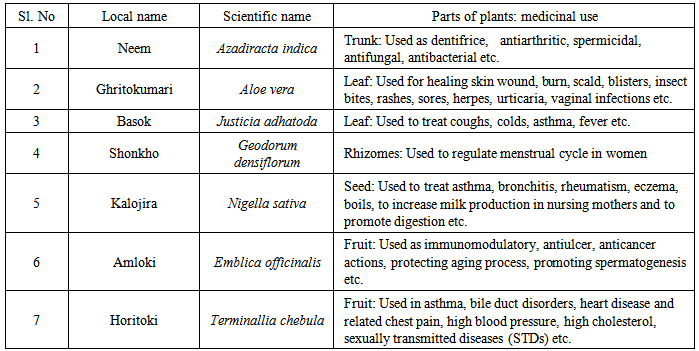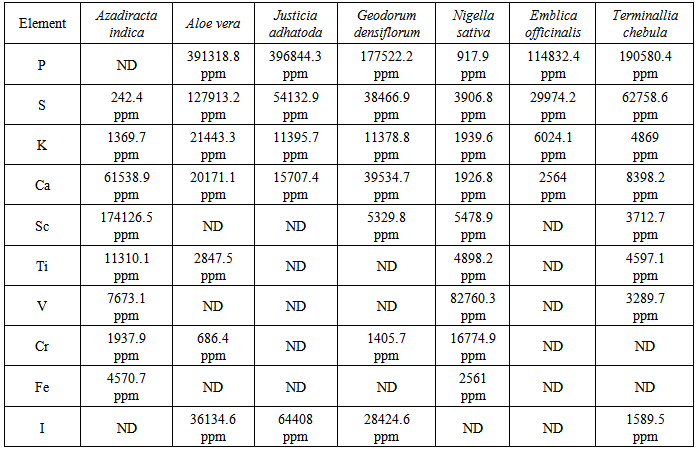-
Paper Information
- Next Paper
- Paper Submission
-
Journal Information
- About This Journal
- Editorial Board
- Current Issue
- Archive
- Author Guidelines
- Contact Us
Journal of Nuclear and Particle Physics
p-ISSN: 2167-6895 e-ISSN: 2167-6909
2014; 4(5): 137-141
doi:10.5923/j.jnpp.20140405.01
Elemental Profile Analysis of Some Traditional Medicinal Plants of Bangladesh Using PIXE Technique
Md. Lokman Hossen1, S. M. Azharul Islam1, Md. Joynal Abedin2, Shirin Akter2, O. F. Rasel3, M. Monjur Ahasan2, Rajada Khatun2, Ashrafun Nahar Monika2
1Department of Physics, Jahangirnagar University, Savar, Dhaka, Bangladesh
2Accelerator Facilities Division, Atomic Energy Center, Dhaka, Bangladesh
3Physics Discipline, Khulna University, Khulna, Bangladesh
Correspondence to: Md. Lokman Hossen, Department of Physics, Jahangirnagar University, Savar, Dhaka, Bangladesh.
| Email: |  |
Copyright © 2014 Scientific & Academic Publishing. All Rights Reserved.
Bangladesh is the darling child of nature where about 722 medicinal plants are available. Photosynthesis and respiration are two major reactions on which lives on the planet- earth depend. Ions of different metal element have an important role in both the reactions. Few elements are essential to the body as nutrients called minerals. Atoms of different element such as Ca, K, Mn, S, P, Mg, Fe, Si, I, Cd, Ti, V, Sc etc of Azadiracta indica, Aloe vera, Justicia adhatoda, Geodorum densiflorum, Nigella sativa, Emblica officinalis and Terminallia chebula were figured out by using PIXE ( Proton Induced X-ray Emission). Well dried pelleted samples of these medicinal plants were irradiated with proton beam accelerated with 3 MV Van de Graff accelerator. The emitted X-rays were collected using Lithium-drifted Silicon [Si(Li)] detector. Maestro and GUPIX software were used for data acquisition and analysis.
Keywords: Elemental, Medicinal Plant, PIXE, [Si(Li)] Detector, Software, Disease
Cite this paper: Md. Lokman Hossen, S. M. Azharul Islam, Md. Joynal Abedin, Shirin Akter, O. F. Rasel, M. Monjur Ahasan, Rajada Khatun, Ashrafun Nahar Monika, Elemental Profile Analysis of Some Traditional Medicinal Plants of Bangladesh Using PIXE Technique, Journal of Nuclear and Particle Physics, Vol. 4 No. 5, 2014, pp. 137-141. doi: 10.5923/j.jnpp.20140405.01.
Article Outline
1. Introduction
- Plants have been used in treating human diseases for thousands of years. A medicinal plant is any plant which, in one or more of its organ, contains substances that can be used for therapeutic purposes or which is a precursors for synthesis of useful drugs. Botanist reported that about seven hundred and twenty two types of medicinal plants are available here in Bangladesh. Some 6000 years ago, it appears that people (Neanderthal man) valued herbs as a medicinal plants. Because of their potential impact on human health, medicinal plants really can play an important role in healing and soothing of various diseases. It is told that minerals are important for their curative and poisonous effect on human health and are responsible for the formation of the active chemical constituents present in medicinal plants [1]. Rocks that contain minerals are break into smaller particles due to the weather effect and then become part of the soil. These minerals, content in the soil, are sucked in by all the living plants. These plants are devoured as food stuff by both animals and human beings. The plants absorb much of the essential elements from the soil in which they grow and serve as indicators of the materialization and are in fact used for this purpose (Avnish, et al., 2010). Heavy metals are the matter of concern in the herbal drugs as certain plants have the tendency to store them from the soil, pol-luted water and atmosphere (Newall et al., 1996, Baker, 1994). All the elements such as various major, minor and trace elements concentration are important for determining effectiveness of medicinal plants in treating various diseases and to understand their pharmacological action.
2. Materials and Methods
2.1. Sampling Area
- All the seven medicinal plants, listed in table 1 with local name, scientific name, parts of plants and medicinal use, were collected from Jahangirnagar University campus. Jahangirnagar University is situated almost at the central region of Bangladesh. Geographically, the campus is situated at 30° 16´N latitude and 90° 52´E longitudes, 32 km North West from the Dhaka city. It embraces about 2.8 km2 (≈ 697.56 acres) of land with distinct ecological habitats and vegetation types (JU diary 05). The average height of this land is about 11.9 m (≈ 39 ft.) from the mean sea level and its soil is highly acidic with many pebbles and yellowish to reddish in colour. The climate of the campus can be categorized by the hot, rainy, humid summers and dry, cool winter. Temperature is very high in summer, which begins to rise in March and April is found the hottest month with a maximum and minimum temperature of 33.9℃ and 23.8℃ respectively. January is the coldest month with maximum temperature 23.1℃ and minimum 14.1℃. Humidity varies between 55-78% (source: Meteorological Dept., Dhaka). Figure 1 represents the sampling area.
 | Figure 1. Map of Jahangirnagar University of Bangladesh from Where Medicinal Plant Samples Were Collected |
|
2.2. Sampling Technique
- All of the plant samples were washed extensively in distilled water in order to remove superficial dust. The leaf samples were dried at (50-80)℃ for 48 hours. The trunk, seed, fruit and bark samples were desiccated in an oven too with temperature of 90℃ for about 100 hours. In this work we use “Memmert Schutzart DIN 40050 – IP 20” to dry wet sample. After cooling the samples at the room temperature, their weight was taken. The process of heating, cooling and weighting was repeated until a constant weight was shown by the electronic balanced to confirm that the samples were completely dried and become moisture free. The dried weighted samples were ground into fine powder using a mortar pestle. Three sub-samples of each plant sample were then prepared and pressed into pellets of 7 mm diameter and 2 mm thickness using a table-top hydraulic press (Pressure: 125 kg/cm2).
2.3. PIXE Technique
- With the advent of nuclear-based analytical methods in the last 40 years, proton induced X-ray emission (PIXE) has established a role in the elemental analysis of different materials. PIXE is a technique with a diverse array of applications in biology, geology, materials science, and others. PIXE spectrometry is one of the important and widely used analytical techniques at MeV energy accelerators. Sven Johansson and co-workers at the department of Physics, Lund University first developed this technique in the early 1970s [2]. PIXE is based on atomic fluorescence by energetic proton and the analysis is performed by measuring the characteristic x-ray emitted from the samples. PIXE is well adapted to measure major, minor, and trace element in different sample matrices such as biomedical, environmental, agriculture and industrial samples. In the present study the technique has been utilized for analysis of medicinal plant samples. The importance of PIXE method is quantitative analysis for multi elemental character.
2.4. Sample Irradiation and Data Acquisition
- In order to X-ray emission, each of the samples was bombarded in an air tight chamber with 2.5 MeV proton beam at the current intensity of (10-20) nA. The proton beam was accelerated with 3 MV Van de Graff accelerator. The emitted X-rays were detected using a liquid-nitrogen-cooled 30 mm2 [Si(Li)] semiconductor detector. The X-ray fluorescence spectra were collected and quantitatively analyzed by the software Maestro and GUPIX respectively. Standard reference materials (SRM) from International Atomic Energy Agency (IAEA) – Apple leaf (1515) and CuS were used for concentration calibration. SRM are the agents with which whether a system is suitable for performing a task or not can be scrutinized. Before performing our study, the energy curve of the samples stated above were compared with the other energy curves of the same materials. The curves were aligned sharply and thus concentration calibration was determined with SRM.
3. Results and Discussion
- Among twenty six essential elements Cr, As, Co, Cu, F, I, Fe, Mn, Mo, Ni, Se, Si, Sn, V and Zn are the paradigm of trace elements which are very important for the nutrition of human body and the other essential major elements are C, H, O, N, S, Ca, P, K, Na, Cl and Mg. Different medicinal plants have their definite role for smooth functioning of our body as these plants contain different level of trace elements (C. h. B. Devi et al., 2013). Total nine different elements namely P, S, K, Ca, Sc, Ti, V, Cr and Fe have been detected in all the plants. The elemental concentration in the medicinal plants are given in Table 2.
|
4. Conclusions
- PIXE technique was employed to the study of elemental constituents of some traditional medicinal plants generally administered in curing many diseases and ailments in Bangladesh. PIXE measurements were carried out using 2.5 MeV collimated proton beams from the 3 MV Van-de-Graaff accelerator of Atomic Energy Center, Dhaka. Medicinal plants are usually used for treating specific diseases and ailments due to different elements absorbed by different medicinal plants. The medicinal plants analysed so far are being used frequently by the inhabitant of Bangladesh. Among all the plants taken, Nigella sativa (Kalojira) is a remedy for all ailments (universal healer). Others are also important for different purposes. Therefore, the results of this study may help the consumers in using them for therapeutic purpose more effectively.
ACKNOWLEDGEMENTS
- The authors are highly grateful to all the staffs of the Accelerator Facilities Division of Atomic Energy Centre, Dhaka for providing the necessary facilities required for this study.
 Abstract
Abstract Reference
Reference Full-Text PDF
Full-Text PDF Full-text HTML
Full-text HTML
